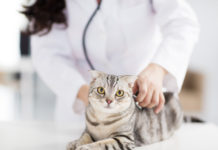Q: I have recently adopted a 6-year-old female cat that was rescued from an outside location (garbage dump) here in Florida. She has been adjusting well and is otherwise an apparently healthy cat, but I have recently noticed that she has black specks/bumps on her chin that were not there before. They don’t seem to be bothering her much, but do you have any idea of what they might be?
A: Thanks for getting in touch and for your care of and concern for this lucky kitty. While it would be best to have this looked at by your veterinarian, perhaps a few thoughts would be helpful.
The first thing I think of when I hear about black spots on cats is fleas, as their feces are blackish in color. Cats with flea infestations may have particles that look like salt and pepper in their fur, with the “salt” being flea eggs and the “pepper” being flea feces. In these cases, if you take the take a feces speck and place it on a moist paper towel, it will usually “bleed” red, due to the concentration of the host’s blood in the feces.
If you only see these spots on the chin, and there is no other evidence of fleas, scratching behavior, or damage to the skin and/or fur, I think the likelihood of fleas causing these bumps is low.
It is quite possible that what you are seeing is what we call “feline acne.” With this condition, the hair follicles become plugged with keratin (a key structural component of skin, hair, and nails), debris, and sebum (and oily substance produced by glands that are associated with the hair follicles) and may ultimately become inflamed and/or infected.
Feline acne is most commonly found on the chin of affected cats. It may appear as either blackish (think of blackheads in people) or reddish bumps. In more advanced cases, pustules may develop, and the lesions may look like pimples.
In most mild cases, cats don’t show any symptoms, but if they progress, feline acne lesions may become inflamed and painful. They may burst and exude whitish or yellowish discharge and may contribute to chronic hair loss.
Your veterinarian may wish to perform a skin scraping to look at the material obtained under a microscope to rule out other potential causes of lesions on the chin, including mange, fungal disease, and a condition called eosinophilic granuloma complex.
In more advanced cases or feline acne, topical and/or systemic antibiotics and/or antimicrobial shampoos may be prescribed to manage any associated bacterial infection. In many, if not most cases, though, merely keeping the area clean with veterinarian-approved antimicrobial wipes and watching for any signs of worsening inflammation are sufficient to keep any problems at bay.
I hope this helps. Please have your kitty’s chin examined by a veterinarian as soon as you can. While there is likely no reason to be overly concerned, it is best to be sure and to be proactive to prevent any worsening of what is likely to be a relatively benign condition.




